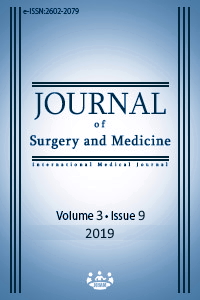Impact of leg elevation added to a 15˚ left lateral incline on maternal hypotension and neonatal outcomes in cesarean section: A randomized clinical study
Keywords:
Pregnancy, Cesarean section, Spinal anesthesia, HypotensionAbstract
Aim: The supine position can cause maternofetal complications by exacerbating hypotension resulting from spinal anesthesia (SA). The aim of this study was to investigate and compare the effect of positioning the patient with a 15˚ left lateral incline and both positioning and elevating both legs on SA-induced hypotension.
Methods: This randomized clinical study was conducted on 200 pregnant women who underwent cesarean section in a university hospital between November 1, 2016 and April 15, 2017.
Pregnant women were separated into 2 groups as the 15˚ left lateral incline (Group 1) and the 15˚ left lateral incline and leg elevation group (Group 2). Mean arterial blood pressure (MAP) and heart rate (HR) values, ephedrine use, neonatal APGAR scores and umbilical cord vein blood gas analysis samples were compared at varying times. After administration of SA, MAP and HR were recorded at the second, fourth, sixth, eighth and tenth minutes until delivery of the infant, every five minutes after delivery until the 30th postpartum minute, and at the end of the surgery.
Results: Two and four minutes after the administration of SA and 20 minutes after delivery, mean HR values of group 2 were significantly higher than that of group 1 (P=0.002, P=0.005, P=0.006, respectively). MAP values were similar in both groups at all time points, however, a greater number of patients in group 1 had MAP <60 mmHg and HR <60 bpm at two and six minutes after the administration of SA.
Conclusion: Positioning the table at a 15˚ incline and leg elevation during ceasarian section may provide maternofetal benefits by reducing the frequency of post-spinal hypotension in pregnant women.
Downloads
References
Sak S, Peker N, Uyanıkoglu H, Binici O, İncebıyık A, Sak ME. Which should be performed; general or spinal anesthesia in elective cesarean section? Med Bull Zeynep Kamil. 2018;49(1):44-8.
Ramanathan J, Bennett K. Pre-eclampsia: fluids, drugs, and anesthetic management. Anesthesiol Clin North Am. 2003;21(1):145-63.
Tsen LC. Anesthesia for cesarean delivery. In: Chestnut DH, Wong CA, Tsen LC et al, edS. Chestnut’s Obstetric Anesthesia: Principles and Practice, 5th ed. Philadelpia (PA): Elsevier Academic Press; 2014. pp. 545-603.
Pederson H, Finster M. Selection and use of local anesthetics. Clin Obstet Gynecol. 1987;30(3):505-14.
Cousins MJ, Bridenbaugh PO. Neural blockade in clinical anesthesia and management of pain. Vol. 494. Philadelpia (PA); Lippincott-Raven; 1998.
Greene NM. Distribution of local anesthetic solutions within the subarachnoid space. Anesth Analg. 1985;64(7):715-30.
Frölich MA. Obstetric Anesthesia. In: Butterworth JF, Mackey DC, Wasnick JD, eds. Morgan & Mikhail’s Clinical Anesthesiology, 5th ed. New York (NY): McGraw- Hill; 2013. pp. 843-76.
Guay J. The effect of neuraxial blocks on surgical blood loss and blood transfusion requirements: a meta-analysis. J Clin Anesth. 2006;18(2):124-8.
Richman JM, Rowlingson AJ, Maine DN, Courpas GE, Weller JF, Wu CL. Does neuraxial anesthesia reduce intraoperative blood loss? A meta-analysis. J Clin Anesth. 2006;18(6):427-35.
Rocke DA, Rout CC. Volume preloading, spinal hypotension and caesarean section. Br J Anaesth. 1995;75(3):257-9.
Singh K, Payal YS, Sharma JP, Nautiyal R. Evaluation of hemodynamic changes after leg wrapping in elective cesarean section under spinal anesthesia. J Obstet Anaesth Crit Care. 2014;4(1):23-8.
Hasanin A, Aiyad A, Elsakka A, Kamel A, Fouad R, Osman M et al. Leg elevation decreases the incidence of post-spinal hypotension in cesarean section: a randomized controlled trial. BMC Anesthesiol. 2017;17(1):60.
Lee SW, Khaw KS, Ngan Kee WD, Leung TY, Critchley LA. Haemodynamic effects from aortocaval compression at different angles of lateral tilt in non-labouring term pregnant women. Br J Anaesth. 2012;109(6):950-6.
Obasuyi BI, Fyneface-Ogan S, Mato CN. A comparison of the haemodynamic effects of lateral and sitting positions during induction of spinal anaesthesia for caesarean section. Int J Obstet Anesth. 2013;22(2):124-8.
Reynolds F, Seed PT. Anaesthesia for caesarean section and neonatal acid-base status: a meta-analysis. Anaesthesia. 2005;60(7):636-53.
Critchley, LA, Short TG, Gin T. Hypotension during subarachnoid anaesthesia: haemodynamic analysis of three treatments. Br J Anaesth. 1994;72(2):151-5.
Downloads
- 1351 1928
Published
Issue
Section
How to Cite
License
Copyright (c) 2019 Feyza Bolcal Çalışır, Aykut Urfalıoğlu, Neşe Yücel, Hafize Öksüz, Gözen Öksüz, Adem Doğaner, Ömer Faruk Boran
This work is licensed under a Creative Commons Attribution-NonCommercial-NoDerivatives 4.0 International License.
















